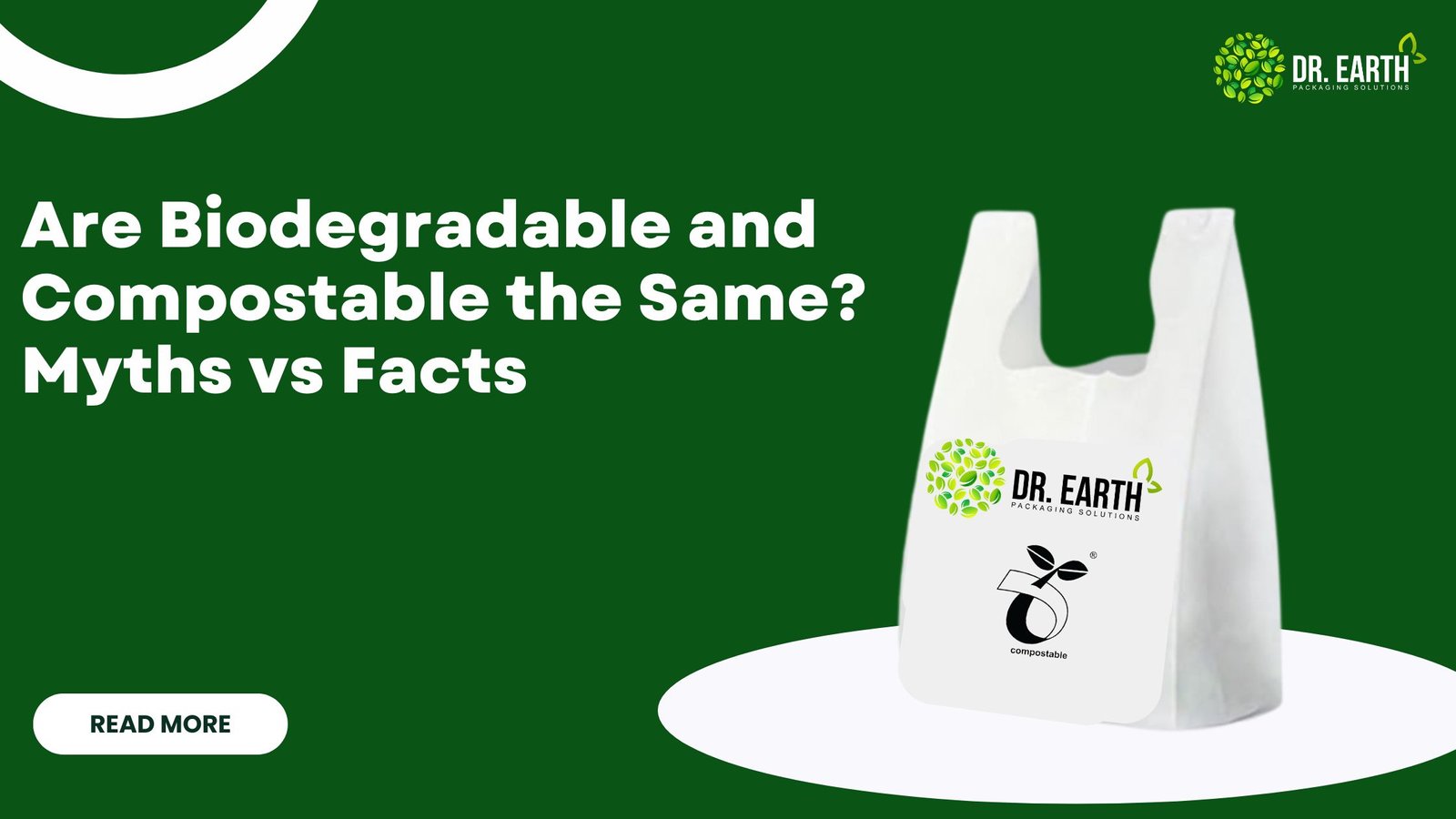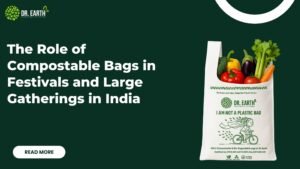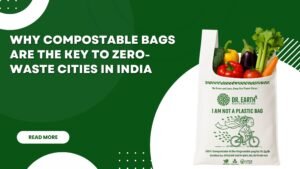
In an age of sustainability taking center stage on a global level, biodegradable and compostable are common words with various marketing products using the terms. From grocery bags, to product packaging, cutlery, and even household waste liners, these words are used interchangeably. But are they really the same? The distinction between biodegradable and compostable is an essential knowledge for both consumers and businesses wanting to lessen their environmental impact. In this blog, we’ll bust the myths and use facts, so you can make informed eco-friendly choices.
Introduction: Why the Confusion Exists
The confusion of biodegradable and compostable terms often occurs as both terms are associated as something that decomposes through natural processes. However, the type of material, time it takes, residue and condition that it decomposes, are unique to biodegradable and compostable. To make matters worse, companies greenwashing have further complicated this issue with products stating that they’re “eco-friendly” or “sustainable” when in reality, they may not be close to those claims.
Myth #1: Biodegradable and Compostable Mean the Same Thing
Fact: No, they don’t. Biodegradable and compostable both suggest to the consumer a material that will break down and return to nature,
Biodegradable suggests it can be broken down but it does not indicate how the material will decompose (like the time frame), what that time frame looks like (for example – 1 week, 1 year etc) and what exactly will be left over (like toxins) once the material is broken down.
Myth #2: All Biodegradable Products Are Environmentally Safe
Fact: This is misleading at best. Indeed, biodegradable materials can leave behind toxic residue, particularly if they contain additives (e.g., plasticizers or heavy metals). Furthermore, some materials will only biodegrade in an industrial composting facility, and cannot biodegrade in natural environments like oceans or forests.
Compostable materials are tested to ensure that they do not leave harmful residues. Upon certification (e.g., CPCB-approved in India), compostable bags and packaging must meet standards for biodegradability, disintegration, and eco-toxicity.
Myth #3: Compostable Items Will Break Down in Any Environment
Fact: Compostable materials have a unique combination of heat, moisture, and microbial activity that must occur in an industrial composting facility. If you were to throw a compostable bag in a landfill, the conditions are anaerobic (lacking oxygen), so it may create methane, a potent greenhouse gas.
Home compostable materials are different because they are designed to break down in natural backyard composting scenarios. Always check the label.
Myth #4: Biodegradable Plastics Are the Solution to Plastic Pollution
Fact: While biodegradable plastics may help with some waste issues, it is not all. Many biodegradable plastics become microplastics instead of fully breaking down and can continue to negatively affect ecosystems.
The best biodegradable is certified compostable, such as cornstarch waste from Dr. Earth compostable bags, composed of renewable resources, which ferments completely safely.
Myth #5: If It Says Biodegradable, You Can Throw It Anywhere
Fact: Disposal matters. Biodegradable waste in regular trash can end up in a landfill that will not degrade well when dumped. Compostable bags in plastic recycling bins means that your compostable bags are contaminating the recycling stream.
Disposing and separating waste into categories is essential. You should only compost in an area with composting infrastructure, should you use compostable (non-recyclable) products; otherwise, you should only use home compostable items you can throw into the general household waste.
The Science Behind Biodegradable vs Compostable
Biodegradable products may include clear petroleum-based plastics with added chemicals to assist in breaking down. Included in biodegradable are often materials that take years to fully degrade, and they may even need UV light or oxygen – neither of which is always present. Naturally, compostable products are made from plant-based materials like cornstarch or PLA (polylactic acid). These will completely break down within 90–180 days in dependent conditions into positive nutrient-rich compost and will not release toxins.
How India Regulates Compostable and Biodegradable Products
In India, compostable plastics have to be certified by the Central Pollution Control Board (CPCB), and only certified products can legally be sold as compostable. Dr. Earth’s bags are CPCB approved compostable bags, and compliant with Indian and international biodegradability standards.
Why Dr. Earth Supports Compostable Over Biodegradable
At Dr. Earth, we see clarity and compliance define true sustainability. Our bags that are 100% compostable:
- Are made from renewable resource, like cornstarch
- Break down to biodegradable byproducts that are non-toxic
- Are CPCB approved
- Reduced plastic pollution and carbon footprint
They are appropriate for use in households, hotels, restaurants, hospitals, etc. Compostable bags provide truly environmentally friendly solution from garbage disposal to grocery shopping.
Use Cases: Where Compostable Bags Make the Most Impact
- Restaurants and food chains discard wet waste responsibly.
- Grocery stores provide sustainable carry bags for the customers.
- Houses can collect organic waste, toilet bins and general waste.
- Hospitals can greatly reduce the risk with using non-toxic bags for bio- waste,
- Events can be hosted without waste with eco packaging.
Tips for Choosing the Right Compostable Product
- Initially, examine the certifications: you always want to see a CPCB or other reputable global certification.
- The source of production: you want to see a natural substance such as cornstarch.
- The “intent” of the product: make sure the bag’s load rating and size is fit for the intended use.
- Compostable vs Home-Compostable: select the product based on your local compost option.
- Don’t be fooled by green washing: don’t take the minimal claims that are often printed on the packaging too literally and beware of misleading claims.
Final Thoughts: Be Informed, Shop Responsibly
In our collective journey to a more sustainable planet, it is the misunderstanding between biodegradable and compostability that has become an important issue that needs our clear definition now more than ever. Misinformation creates the same poor waste management cycles that we are working to avoid in our new environment.
By choosing truly compostable products like Dr. Earth’s products, you are not only choosing an environmental better choice to make, but you are also demonstrating to the industry your standards.
Now, let’s move beyond the labels and into the action required, one bag at a time.
FAQs About Biodegradable vs Compostable
Q1. Is compostable better than biodegradable?
Ans- Yes, because compostable products fully break down into safe, non-toxic elements under the right conditions.
Q2. Are Dr. Earth bags biodegradable or compostable?
Ans- They are 100% compostable and CPCB-approved, making them safe and environmentally effective.
Q3. Can compostable bags go into plastic recycling bins?
Ans- No. They must be composted, not recycled with plastic.
Q4. What are Dr. Earth compostable bags made from?
Ans- They’re made from plant-based materials like cornstarch and other renewable biopolymers.
Q5. How do I know if a product is genuinely compostable?
Ans-Look for CPCB certification and check if it meets EN 13432 or ASTM D6400 standards.
Share:
Related Posts














